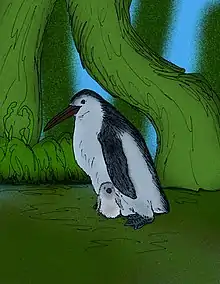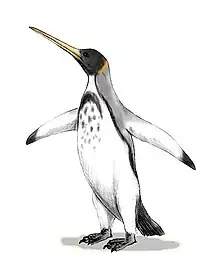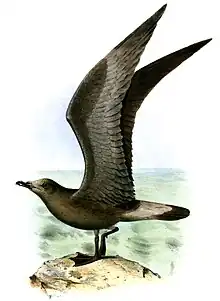| Crossvallia Temporal range: Late Paleocene ~ | |
|---|---|
 | |
| restoration of C. unienwillia | |
| Scientific classification | |
| Domain: | Eukaryota |
| Kingdom: | Animalia |
| Phylum: | Chordata |
| Class: | Aves |
| Order: | Sphenisciformes |
| Family: | Spheniscidae |
| Genus: | †Crossvallia Tambussi et al. 2005 |
| Species | |
|
†Crossvallia unienwillia (type) (fossil) †?Crossvallia waiparensis (fossil) | |
Crossvallia is an extinct genus of penguins. It includes two species, C. unienwillia and ?C. waiparensis. Their anatomy suggests that the genus is closely related to the Anthropornithinae.[1]
Taxonomy
Order Sphenisciformes
- Family Spheniscidae
C. unienwillia was the first of the genus to be described, whose remains were recovered from and named after the Late Paleocene Cross Valley Formation on Seymour Island, Antarctica.[2] It measured about 140 cm (4.6 ft).[1]
In August 2019, a new species of Crossvallia, C. waiparensis, was described based on leg bone fossils from Waipara, New Zealand.[3] It measured about 160 cm (5.2 ft) and weighed around 70–80 kg, being about 154-176 lb.[4] This is significantly large, considering the largest extant penguin species, the Emperor penguin, can be roughly around 121.9 cm,[5] and weigh up to almost 36 kg. It is thought to have lived in the final of Cretaceous and Paleocene 66–56 million years ago, and close relatives of C. waiparensis may have lived in the Antarctic.[4] The fossils were discovered in 2019 by amateur palaeontologist Leigh Love.[6]
References
- 1 2 Tambussi, Claudia P.; Reguero, Marcelo A.; Marenssi, Sergio A.; Santillana, Sergio N. (2005). "Crossvallia unienwillia, a new Spheniscidae (Sphenisciformes, Aves) from the Late Paleocene of Antarctica". Geobios. 38 (5): 667–675. Bibcode:2005Geobi..38..667T. doi:10.1016/j.geobios.2004.02.003.
- ↑ Cross Valley at Fossilworks.org
- ↑ Mayr, Gerald; De Pietri, Vanesa L.; Love, Leigh; Mannering, Al; Scofield, R. Paul (2019). "Leg bones of a new penguin species from the Waipara Greensand add to the diversity of very large-sized Sphenisciformes in the Paleocene of New Zealand". Alcheringa. 44: 194–201. doi:10.1080/03115518.2019.1641619.
- 1 2 "Pingvin". Magyar Narancs (in Hungarian). XXXI (34): 7. 2019-08-22. ISSN 1586-0647.
- ↑ Magazine, Smithsonian; Katz, Brigit. "A Human-Sized Penguin Once Waddled Through New Zealand". Smithsonian Magazine. Retrieved 2022-03-19.
- ↑ "Human-sized penguin discovered in Waipara". RNZ. 2019-08-14. Retrieved 2019-08-14.

